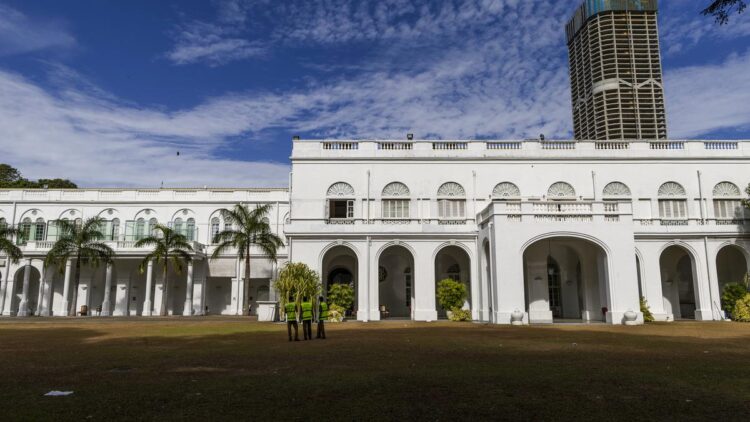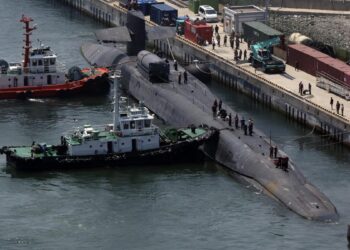[ad_1]
The main ask — and the most popular chant — of the ‘Janatha Aragalaya’ [people’s struggle] witnessed in Sri Lanka last year was “Gota go home”. Scores of angry citizens, who took to the streets to protest acute shortages of essentials and long power cuts, squarely blamed the country’s most powerful leader for their misery. They deemed the former military man unfit to govern or occupy the country’s top office, and ousted him dramatically.
At the same time, some who were part of the protest movement confronted another question. Will the mere ousting of a failed President do, if ‘system change’ is what the country needs? What if another leader in his place resorts to destructive policy choices, such as Mr. Gotabaya’s overnight ban on agrochemicals in 2021, that continues to hurt farmers and the country’s annual crop yield? An impulsive leader wasn’t the only problem, they concluded. The office of the executive president, which bestows unchecked powers on one individual, was as much, if not more of a problem.
The Executive Presidency system came under focus, and the call to abolish it emerged loud and clear and dominated public discourse for a while.
Origins of unlimited power
The demand to abolish the executive presidency, however, did not seem outlandish to Sri Lankans. It wasn’t as new, virtually every President who has held office since it was introduced in 1978 had promised to do away with it, even if they conveniently forgot the promise once in that addictive seat.
From the time of its Independence in 1948, Sri Lanka was a parliamentary democracy. It adopted a republican constitution in 1972, in which parliamentary democracy continued. In 1978, the second republican constitution changed it into a presidential form of government and vested the President’s office with enormous powers.
The resistance to this system of governance, from within Sri Lanka’s polity and civil society, began just as former President J.R. Jayewardene began toying with the idea in the early 1971s, even before enshrining it in Sri Lanka’s second republican constitution in 1978. Sri Lanka’s Left, especially, played a major role, according to senior constitutional lawyer Jayampathy Wickramaratne, who cited key debates from the time, in a media article some years ago.
Colvin R. de Silva, a founder of the Trotskyist Lanka Sama Samaja Party (LSSP) and one of the finest legislators in the region, succinctly captured the dangers of executive presidency in the Constituent Assembly in 1971. Being Minister of Constitutional Affairs at the time, he contended, “There is undoubtedly one virtue in this system of Parliament … and that is that the chief executive of the day is answerable directly to the representatives of the people continuously by reason of the fact that the Prime Minister can remain Prime Minister only so long as he can command the confidence of that assembly. We do not want either Presidents or Prime Ministers who can ride roughshod over the people and, therefore, first of all, over the people’s representatives. There is no virtue in having a strong man against the people.”
Subsequently, when the J.R. Jayewardene-led United National Party (UNP) won a five-sixths majority in the 1977 general elections, promising economic progress with open economic reforms, the Left was wiped out of Parliament. Even so, leftist politicians continued to spearhead the campaign against executive presidency from the outside. N.M. Perera, also a leader of the LSSP, wrote a scathing critique of the 1978 Constitution.
The reign of the Executive
However, executive presidency soon found a secure spot in its architect Jayewardene’s office, and the new President, in turn, found in the system all the power he needed to nourish his ambitions. Two years into office, he brutally crushed a massive general strike of workers in 1980, sacking about 40,000 public sector workers using emergency regulations. With the same powers, President Jayewardene did little to curb Sinhalese mobs that killed and looted scores of Tamils in the anti-Tamil pogrom three years later. The bloodbath of July 1983, which he is accused of condoning and even backing, sparked a deadly civil war that gripped the island nation for about three decades, costing tens of thousands of Tamil civilian lives.
In the following decades, Sri Lanka saw half a dozen other presidents elected to the office, with almost all of them promising to abolish executive presidency once elected. Former President Chandrika Bandaranaike Kumaratunge proposed the abolition of the executive presidency and won the 1994 presidential election. But eventually, she did not abolish it.
Further, apart from habitually breaking the poll pledge, leaders occupying the highest office were seen abusing their unfettered powers. In fact, they sought to make it even more powerful.
Months after Mahinda Rajapaksa was elected President for the second time in 2010, on the heels of the military defeat of the LTTE which his party aggressively sold as “war victory” to its southern Sinhalese constituency, his government passed the 18th Amendment. It made the President even more powerful, by removing the two-term limit, and important checks and balances on the exercise of executive power.
Empowering Parliament
However, in what was widely seen as a rare and welcome departure during his successor Maithripala Sirisena’s term, the government, co-led by Ranil Wickremesinghe as Prime Minister, passed the 19th Amendment to the Sri Lankan Constitution.
It was the first instance of a constitutional amendment seeking to empower parliament by clipping executive powers. Except, even the residual powers of the office gave Mr. Sirisena the confidence to abruptly sack Mr. Wickremesinghe and dissolve Parliament, triggering a constitutional crisis for over 50 days in late 2018. The Supreme Court ruled that the President’s move was illegal. Lawyers who had mounted a legal challenge based their argument primarily on the 19th Amendment.
In November 2019, Gotabaya Rajapaksa won big in the presidential polls and in less than a year, his government overturned the 19th Amendment, passing the 20th that effectively restored the previously reduced presidential powers.
The Wickremesinghe administration, in September 2022, passed the 21st amendment, claiming to return to the arrangement envisaged in the 19th Amendment, but critics dismissed it as an “eyewash”. The attempts to “tame” the presidency, in their experience, had proved futile. It is not a system that lends itself to reform, it is one that allows concentration of excessive power, and needs to be repealed in its entirety, they argued.
As of today, the president can still hold any number of ministerial portfolios, which the 19th Amendment sought to limit and disallow. The president still has the power to determine the number of ministers and ministries, as well as to assign subjects and functions to such ministries. The president can use his discretion in appointing secretaries to the ministries as well. The independence of the Constitutional Council which enables and monitors independent commissions has also come into question.
In vesting all powers with the Centre, that too in one office, the executive presidential system seriously restricts the scope of governance at the provincial level. Even within the limited ambit of provincial council administrations, the Governor as a representative of the Executive, wields considerable powers.
Colvin R. de Silva called the system of government under Sri Lanka’s 1978 Constitution a “constitutional presidential dictatorship dressed in the raiment of a parliamentary democracy.”
Sri Lanka is currently witnessing frequent protests by worker unions and university students, against persisting economic hardships and austerity measures. Police are responding with tear gas and water cannon. Critics of President Ranil Wickremesinghe are already likening him to his uncle J.R. Jayewardene.
Sri Lankans have debated the need to abolish executive presidency for decades now. Last year’s crisis yet again put this model of governance in sharp focus. But the island nation is yet to find a leader who would get to the top, and then agree to renounce his or her own power.
This is the last part of a series of articles looking at Sri Lanka’s economic recovery and political course
[ad_2]
[ad_1]
The main ask — and the most popular chant — of the ‘Janatha Aragalaya’ [people’s struggle] witnessed in Sri Lanka last year was “Gota go home”. Scores of angry citizens, who took to the streets to protest acute shortages of essentials and long power cuts, squarely blamed the country’s most powerful leader for their misery. They deemed the former military man unfit to govern or occupy the country’s top office, and ousted him dramatically.
At the same time, some who were part of the protest movement confronted another question. Will the mere ousting of a failed President do, if ‘system change’ is what the country needs? What if another leader in his place resorts to destructive policy choices, such as Mr. Gotabaya’s overnight ban on agrochemicals in 2021, that continues to hurt farmers and the country’s annual crop yield? An impulsive leader wasn’t the only problem, they concluded. The office of the executive president, which bestows unchecked powers on one individual, was as much, if not more of a problem.
The Executive Presidency system came under focus, and the call to abolish it emerged loud and clear and dominated public discourse for a while.
Origins of unlimited power
The demand to abolish the executive presidency, however, did not seem outlandish to Sri Lankans. It wasn’t as new, virtually every President who has held office since it was introduced in 1978 had promised to do away with it, even if they conveniently forgot the promise once in that addictive seat.
From the time of its Independence in 1948, Sri Lanka was a parliamentary democracy. It adopted a republican constitution in 1972, in which parliamentary democracy continued. In 1978, the second republican constitution changed it into a presidential form of government and vested the President’s office with enormous powers.
The resistance to this system of governance, from within Sri Lanka’s polity and civil society, began just as former President J.R. Jayewardene began toying with the idea in the early 1971s, even before enshrining it in Sri Lanka’s second republican constitution in 1978. Sri Lanka’s Left, especially, played a major role, according to senior constitutional lawyer Jayampathy Wickramaratne, who cited key debates from the time, in a media article some years ago.
Colvin R. de Silva, a founder of the Trotskyist Lanka Sama Samaja Party (LSSP) and one of the finest legislators in the region, succinctly captured the dangers of executive presidency in the Constituent Assembly in 1971. Being Minister of Constitutional Affairs at the time, he contended, “There is undoubtedly one virtue in this system of Parliament … and that is that the chief executive of the day is answerable directly to the representatives of the people continuously by reason of the fact that the Prime Minister can remain Prime Minister only so long as he can command the confidence of that assembly. We do not want either Presidents or Prime Ministers who can ride roughshod over the people and, therefore, first of all, over the people’s representatives. There is no virtue in having a strong man against the people.”
Subsequently, when the J.R. Jayewardene-led United National Party (UNP) won a five-sixths majority in the 1977 general elections, promising economic progress with open economic reforms, the Left was wiped out of Parliament. Even so, leftist politicians continued to spearhead the campaign against executive presidency from the outside. N.M. Perera, also a leader of the LSSP, wrote a scathing critique of the 1978 Constitution.
The reign of the Executive
However, executive presidency soon found a secure spot in its architect Jayewardene’s office, and the new President, in turn, found in the system all the power he needed to nourish his ambitions. Two years into office, he brutally crushed a massive general strike of workers in 1980, sacking about 40,000 public sector workers using emergency regulations. With the same powers, President Jayewardene did little to curb Sinhalese mobs that killed and looted scores of Tamils in the anti-Tamil pogrom three years later. The bloodbath of July 1983, which he is accused of condoning and even backing, sparked a deadly civil war that gripped the island nation for about three decades, costing tens of thousands of Tamil civilian lives.
In the following decades, Sri Lanka saw half a dozen other presidents elected to the office, with almost all of them promising to abolish executive presidency once elected. Former President Chandrika Bandaranaike Kumaratunge proposed the abolition of the executive presidency and won the 1994 presidential election. But eventually, she did not abolish it.
Further, apart from habitually breaking the poll pledge, leaders occupying the highest office were seen abusing their unfettered powers. In fact, they sought to make it even more powerful.
Months after Mahinda Rajapaksa was elected President for the second time in 2010, on the heels of the military defeat of the LTTE which his party aggressively sold as “war victory” to its southern Sinhalese constituency, his government passed the 18th Amendment. It made the President even more powerful, by removing the two-term limit, and important checks and balances on the exercise of executive power.
Empowering Parliament
However, in what was widely seen as a rare and welcome departure during his successor Maithripala Sirisena’s term, the government, co-led by Ranil Wickremesinghe as Prime Minister, passed the 19th Amendment to the Sri Lankan Constitution.
It was the first instance of a constitutional amendment seeking to empower parliament by clipping executive powers. Except, even the residual powers of the office gave Mr. Sirisena the confidence to abruptly sack Mr. Wickremesinghe and dissolve Parliament, triggering a constitutional crisis for over 50 days in late 2018. The Supreme Court ruled that the President’s move was illegal. Lawyers who had mounted a legal challenge based their argument primarily on the 19th Amendment.
In November 2019, Gotabaya Rajapaksa won big in the presidential polls and in less than a year, his government overturned the 19th Amendment, passing the 20th that effectively restored the previously reduced presidential powers.
The Wickremesinghe administration, in September 2022, passed the 21st amendment, claiming to return to the arrangement envisaged in the 19th Amendment, but critics dismissed it as an “eyewash”. The attempts to “tame” the presidency, in their experience, had proved futile. It is not a system that lends itself to reform, it is one that allows concentration of excessive power, and needs to be repealed in its entirety, they argued.
As of today, the president can still hold any number of ministerial portfolios, which the 19th Amendment sought to limit and disallow. The president still has the power to determine the number of ministers and ministries, as well as to assign subjects and functions to such ministries. The president can use his discretion in appointing secretaries to the ministries as well. The independence of the Constitutional Council which enables and monitors independent commissions has also come into question.
In vesting all powers with the Centre, that too in one office, the executive presidential system seriously restricts the scope of governance at the provincial level. Even within the limited ambit of provincial council administrations, the Governor as a representative of the Executive, wields considerable powers.
Colvin R. de Silva called the system of government under Sri Lanka’s 1978 Constitution a “constitutional presidential dictatorship dressed in the raiment of a parliamentary democracy.”
Sri Lanka is currently witnessing frequent protests by worker unions and university students, against persisting economic hardships and austerity measures. Police are responding with tear gas and water cannon. Critics of President Ranil Wickremesinghe are already likening him to his uncle J.R. Jayewardene.
Sri Lankans have debated the need to abolish executive presidency for decades now. Last year’s crisis yet again put this model of governance in sharp focus. But the island nation is yet to find a leader who would get to the top, and then agree to renounce his or her own power.
This is the last part of a series of articles looking at Sri Lanka’s economic recovery and political course
[ad_2]
















